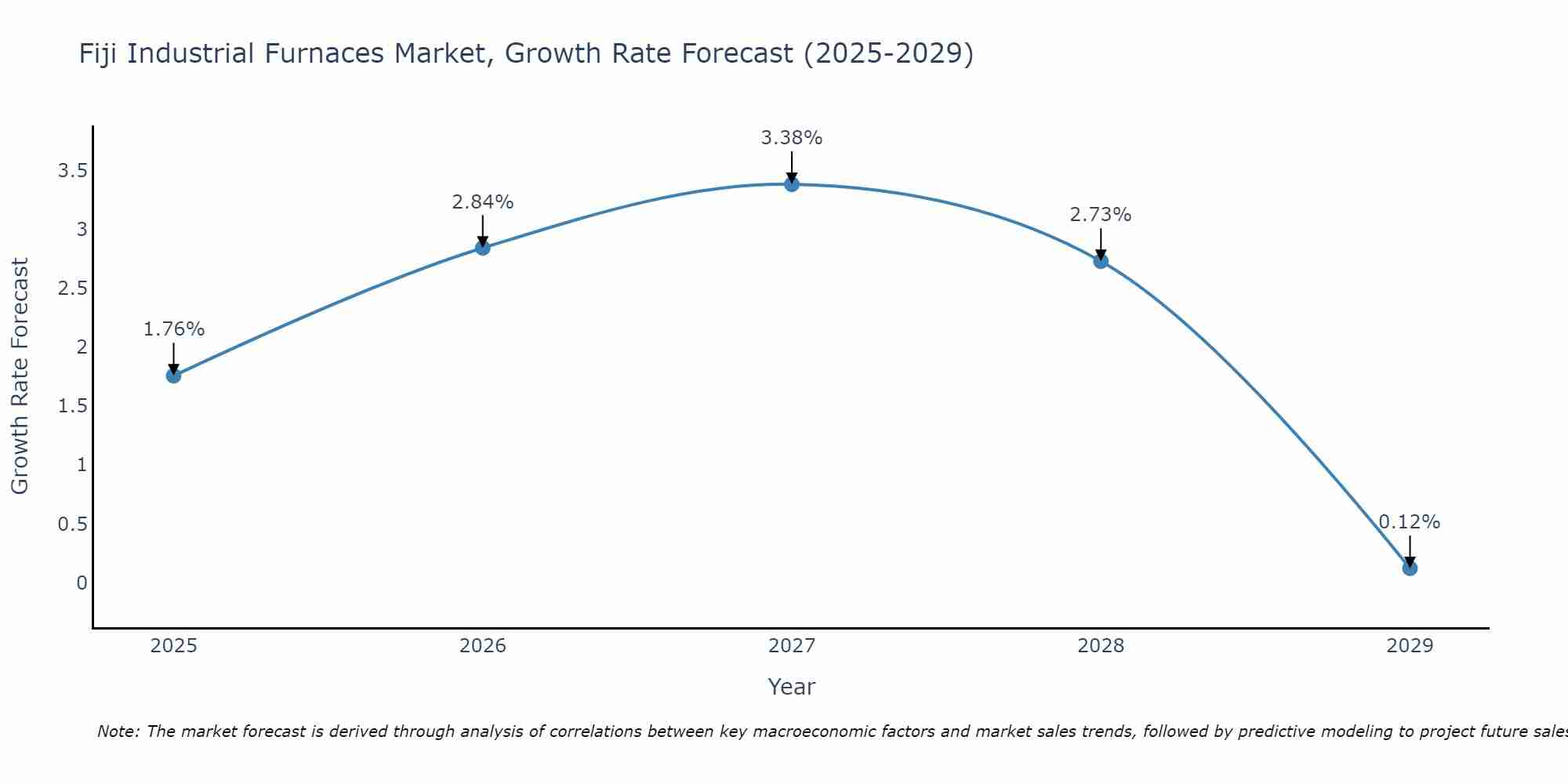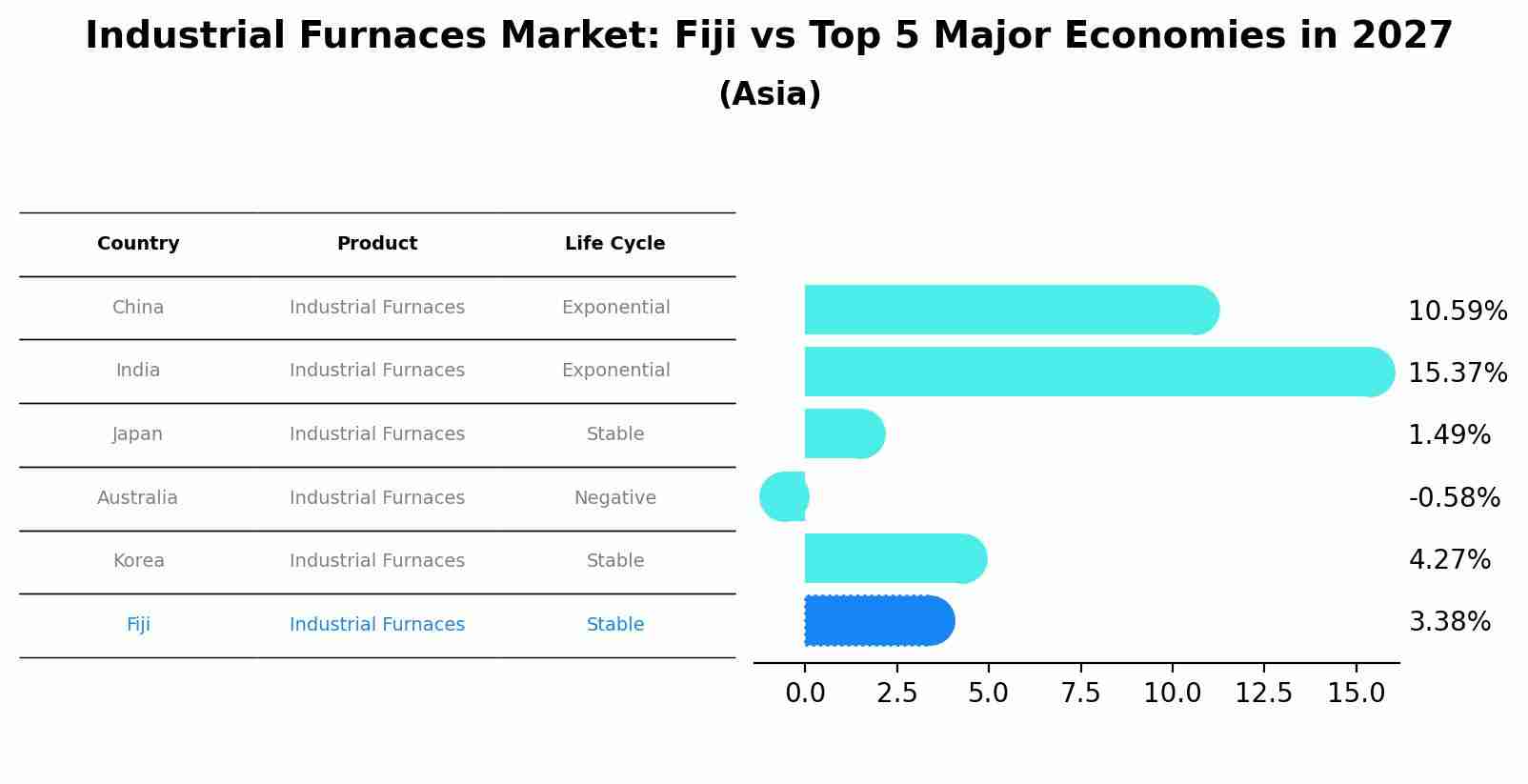Fiji Industrial Furnaces Market (2025-2031) | Outlook, Segmentation, Industry, Analysis, Forecast, Size, Revenue, Share, Trends, Companies, Value & Growth
| Product Code: ETC5402361 | Publication Date: Nov 2023 | Updated Date: Apr 2025 | Product Type: Market Research Report | |
| Publisher: 6Wresearch | Author: Bhawna Singh | No. of Pages: 60 | No. of Figures: 30 | No. of Tables: 5 |
Fiji Industrial Furnaces Market Size Growth Rate
The Fiji Industrial Furnaces Market is projected to witness mixed growth rate patterns during 2025 to 2029. Growth accelerates to 3.38% in 2027, following an initial rate of 1.76%, before easing to 0.12% at the end of the period.

Industrial Furnaces Market: Fiji vs Top 5 Major Economies in 2027 (Asia)
Fiji's Industrial Furnaces market is anticipated to experience a stable growth rate of 3.38% by 2027, reflecting trends observed in the largest economy China, followed by India, Japan, Australia and South Korea.

Fiji Industrial Furnaces Market Overview
The industrial furnaces market in Fiji is driven by the need for high-temperature heating in industries such as metal processing, ceramics, and glass manufacturing. Industrial furnaces play a crucial role in shaping, melting, and treating materials under controlled temperatures. With the continued growth of Fiji`s manufacturing sector, especially in materials production, the demand for industrial furnaces is set to increase.
Drivers of the market
The industrial furnaces market in Fiji is driven by the growing demand for heating and thermal treatment solutions in industries such as metalworking, ceramics, and glass manufacturing. Furnaces are essential in processes such as melting, sintering, and heat treatment of materials, and their demand is rising with the growth of the manufacturing sector. The increasing focus on energy efficiency and the adoption of advanced furnace technologies that reduce emissions and fuel consumption are key factors driving market growth. Additionally, as Fijis industrial sector continues to expand, particularly in the production of metals and glass, the need for high-performance industrial furnaces is expected to increase.
Challenges of the market
The industrial furnaces market in Fiji is constrained by limited demand from the countrys small-scale industrial and manufacturing sectors. Industrial furnaces are essential for high-temperature processes such as metal casting, ceramics, and heat treatment. However, the lack of large-scale industrial facilities in Fiji reduces the demand for furnaces. The high cost of importing furnaces and related components, along with the lack of local expertise in furnace installation and maintenance, makes these systems expensive for businesses in Fiji. This reduces the markets growth potential and limits the adoption of industrial furnaces in the country.
Government Policy of the market
Fijis government has implemented policies to modernize industrial furnaces with energy-efficient and environmentally friendly technologies. Regulations require industries to upgrade outdated furnace systems to reduce emissions and fuel consumption. Additionally, partnerships with international organizations provide technical support and funding for sustainable industrial furnace projects.
Key Highlights of the Report:
- Fiji Industrial Furnaces Market Outlook
- Market Size of Fiji Industrial Furnaces Market, 2024
- Forecast of Fiji Industrial Furnaces Market, 2031
- Historical Data and Forecast of Fiji Industrial Furnaces Revenues & Volume for the Period 2021-2031
- Fiji Industrial Furnaces Market Trend Evolution
- Fiji Industrial Furnaces Market Drivers and Challenges
- Fiji Industrial Furnaces Price Trends
- Fiji Industrial Furnaces Porter`s Five Forces
- Fiji Industrial Furnaces Industry Life Cycle
- Historical Data and Forecast of Fiji Industrial Furnaces Market Revenues & Volume By Arrangement for the Period 2021-2031
- Historical Data and Forecast of Fiji Industrial Furnaces Market Revenues & Volume By Tube Or Clamshell Type for the Period 2021-2031
- Historical Data and Forecast of Fiji Industrial Furnaces Market Revenues & Volume By Box Type for the Period 2021-2031
- Historical Data and Forecast of Fiji Industrial Furnaces Market Revenues & Volume By Car Bottom Type for the Period 2021-2031
- Historical Data and Forecast of Fiji Industrial Furnaces Market Revenues & Volume By Operation for the Period 2021-2031
- Historical Data and Forecast of Fiji Industrial Furnaces Market Revenues & Volume By Gas/burner Operated for the Period 2021-2031
- Historical Data and Forecast of Fiji Industrial Furnaces Market Revenues & Volume By Electrically Operated for the Period 2021-2031
- Historical Data and Forecast of Fiji Industrial Furnaces Market Revenues & Volume By Application for the Period 2021-2031
- Historical Data and Forecast of Fiji Industrial Furnaces Market Revenues & Volume By Atmosphere for the Period 2021-2031
- Historical Data and Forecast of Fiji Industrial Furnaces Market Revenues & Volume By Vacuum for the Period 2021-2031
- Fiji Industrial Furnaces Import Export Trade Statistics
- Market Opportunity Assessment By Arrangement
- Market Opportunity Assessment By Operation
- Market Opportunity Assessment By Application
- Fiji Industrial Furnaces Top Companies Market Share
- Fiji Industrial Furnaces Competitive Benchmarking By Technical and Operational Parameters
- Fiji Industrial Furnaces Company Profiles
- Fiji Industrial Furnaces Key Strategic Recommendations
Frequently Asked Questions About the Market Study (FAQs):
1 Executive Summary |
2 Introduction |
2.1 Key Highlights of the Report |
2.2 Report Description |
2.3 Market Scope & Segmentation |
2.4 Research Methodology |
2.5 Assumptions |
3 Fiji Industrial Furnaces Market Overview |
3.1 Fiji Country Macro Economic Indicators |
3.2 Fiji Industrial Furnaces Market Revenues & Volume, 2021 & 2031F |
3.3 Fiji Industrial Furnaces Market - Industry Life Cycle |
3.4 Fiji Industrial Furnaces Market - Porter's Five Forces |
3.5 Fiji Industrial Furnaces Market Revenues & Volume Share, By Arrangement, 2021 & 2031F |
3.6 Fiji Industrial Furnaces Market Revenues & Volume Share, By Operation, 2021 & 2031F |
3.7 Fiji Industrial Furnaces Market Revenues & Volume Share, By Application, 2021 & 2031F |
4 Fiji Industrial Furnaces Market Dynamics |
4.1 Impact Analysis |
4.2 Market Drivers |
4.3 Market Restraints |
5 Fiji Industrial Furnaces Market Trends |
6 Fiji Industrial Furnaces Market Segmentations |
6.1 Fiji Industrial Furnaces Market, By Arrangement |
6.1.1 Overview and Analysis |
6.1.2 Fiji Industrial Furnaces Market Revenues & Volume, By Tube Or Clamshell Type, 2021-2031F |
6.1.3 Fiji Industrial Furnaces Market Revenues & Volume, By Box Type, 2021-2031F |
6.1.4 Fiji Industrial Furnaces Market Revenues & Volume, By Car Bottom Type, 2021-2031F |
6.2 Fiji Industrial Furnaces Market, By Operation |
6.2.1 Overview and Analysis |
6.2.2 Fiji Industrial Furnaces Market Revenues & Volume, By Gas/burner Operated, 2021-2031F |
6.2.3 Fiji Industrial Furnaces Market Revenues & Volume, By Electrically Operated, 2021-2031F |
6.3 Fiji Industrial Furnaces Market, By Application |
6.3.1 Overview and Analysis |
6.3.2 Fiji Industrial Furnaces Market Revenues & Volume, By Atmosphere, 2021-2031F |
6.3.3 Fiji Industrial Furnaces Market Revenues & Volume, By Vacuum, 2021-2031F |
7 Fiji Industrial Furnaces Market Import-Export Trade Statistics |
7.1 Fiji Industrial Furnaces Market Export to Major Countries |
7.2 Fiji Industrial Furnaces Market Imports from Major Countries |
8 Fiji Industrial Furnaces Market Key Performance Indicators |
9 Fiji Industrial Furnaces Market - Opportunity Assessment |
9.1 Fiji Industrial Furnaces Market Opportunity Assessment, By Arrangement, 2021 & 2031F |
9.2 Fiji Industrial Furnaces Market Opportunity Assessment, By Operation, 2021 & 2031F |
9.3 Fiji Industrial Furnaces Market Opportunity Assessment, By Application, 2021 & 2031F |
10 Fiji Industrial Furnaces Market - Competitive Landscape |
10.1 Fiji Industrial Furnaces Market Revenue Share, By Companies, 2024 |
10.2 Fiji Industrial Furnaces Market Competitive Benchmarking, By Operating and Technical Parameters |
11 Company Profiles |
12 Recommendations | 13 Disclaimer |
- Single User License$ 1,995
- Department License$ 2,400
- Site License$ 3,120
- Global License$ 3,795
Search
Related Reports
- ASEAN Bearings Market (2025-2031) | Strategy, Consumer Insights, Analysis, Investment Trends, Opportunities, Growth, Size, Share, Industry, Revenue, Segments, Value, Segmentation, Supply, Forecast, Restraints, Outlook, Competition, Drivers, Trends, Demand, Pricing Analysis, Competitive, Strategic Insights, Companies, Challenges
- Europe Flooring Market (2025-2031) | Outlook, Share, Industry, Trends, Forecast, Companies, Revenue, Size, Analysis, Growth & Value
- Saudi Arabia Manlift Market (2025-2031) | Outlook, Size, Growth, Trends, Companies, Industry, Revenue, Value, Share, Forecast & Analysis
- Uganda Excavator, Crane, and Wheel Loaders Market (2025-2031) | Strategy, Consumer Insights, Analysis, Investment Trends, Opportunities, Growth, Size, Share, Industry, Revenue, Segments, Value, Segmentation, Supply, Forecast, Restraints, Outlook, Competition, Drivers, Trends, Demand, Pricing Analysis, Competitive, Strategic Insights, Companies, Challenges
- Rwanda Excavator, Crane, and Wheel Loaders Market (2025-2031) | Strategy, Consumer Insights, Analysis, Investment Trends, Opportunities, Growth, Size, Share, Industry, Revenue, Segments, Value, Segmentation, Supply, Forecast, Restraints, Outlook, Competition, Drivers, Trends, Demand, Pricing Analysis, Competitive, Strategic Insights, Companies, Challenges
- Kenya Excavator, Crane, and Wheel Loaders Market (2025-2031) | Strategy, Consumer Insights, Analysis, Investment Trends, Opportunities, Growth, Size, Share, Industry, Revenue, Segments, Value, Segmentation, Supply, Forecast, Restraints, Outlook, Competition, Drivers, Trends, Demand, Pricing Analysis, Competitive, Strategic Insights, Companies, Challenges
- Angola Excavator, Crane, and Wheel Loaders Market (2025-2031) | Strategy, Consumer Insights, Analysis, Investment Trends, Opportunities, Growth, Size, Share, Industry, Revenue, Segments, Value, Segmentation, Supply, Forecast, Restraints, Outlook, Competition, Drivers, Trends, Demand, Pricing Analysis, Competitive, Strategic Insights, Companies, Challenges
- Israel Intelligent Transport System Market (2025-2031) | Strategy, Consumer Insights, Analysis, Investment Trends, Opportunities, Growth, Size, Share, Industry, Revenue, Segments, Value, Segmentation, Supply, Forecast, Restraints, Outlook, Competition, Drivers, Trends, Demand, Pricing Analysis, Competitive, Strategic Insights, Companies, Challenges
- Uganda Precast and Aggregate Market (2025-2031) | Strategy, Consumer Insights, Analysis, Investment Trends, Opportunities, Growth, Size, Share, Industry, Revenue, Segments, Value, Segmentation, Supply, Forecast, Restraints, Outlook, Competition, Drivers, Trends, Demand, Pricing Analysis, Competitive, Strategic Insights, Companies, Challenges
- Australia IT Asset Disposal Market (2025-2031) | Strategy, Consumer Insights, Analysis, Investment Trends, Opportunities, Growth, Size, Share, Industry, Revenue, Segments, Value, Segmentation, Supply, Forecast, Restraints, Outlook, Competition, Drivers, Trends, Demand, Pricing Analysis, Competitive, Strategic Insights, Companies, Challenges
Industry Events and Analyst Meet
Our Clients
Whitepaper
- Middle East & Africa Commercial Security Market Click here to view more.
- Middle East & Africa Fire Safety Systems & Equipment Market Click here to view more.
- GCC Drone Market Click here to view more.
- Middle East Lighting Fixture Market Click here to view more.
- GCC Physical & Perimeter Security Market Click here to view more.
6WResearch In News
- Doha a strategic location for EV manufacturing hub: IPA Qatar
- Demand for luxury TVs surging in the GCC, says Samsung
- Empowering Growth: The Thriving Journey of Bangladesh’s Cable Industry
- Demand for luxury TVs surging in the GCC, says Samsung
- Video call with a traditional healer? Once unthinkable, it’s now common in South Africa
- Intelligent Buildings To Smooth GCC’s Path To Net Zero













